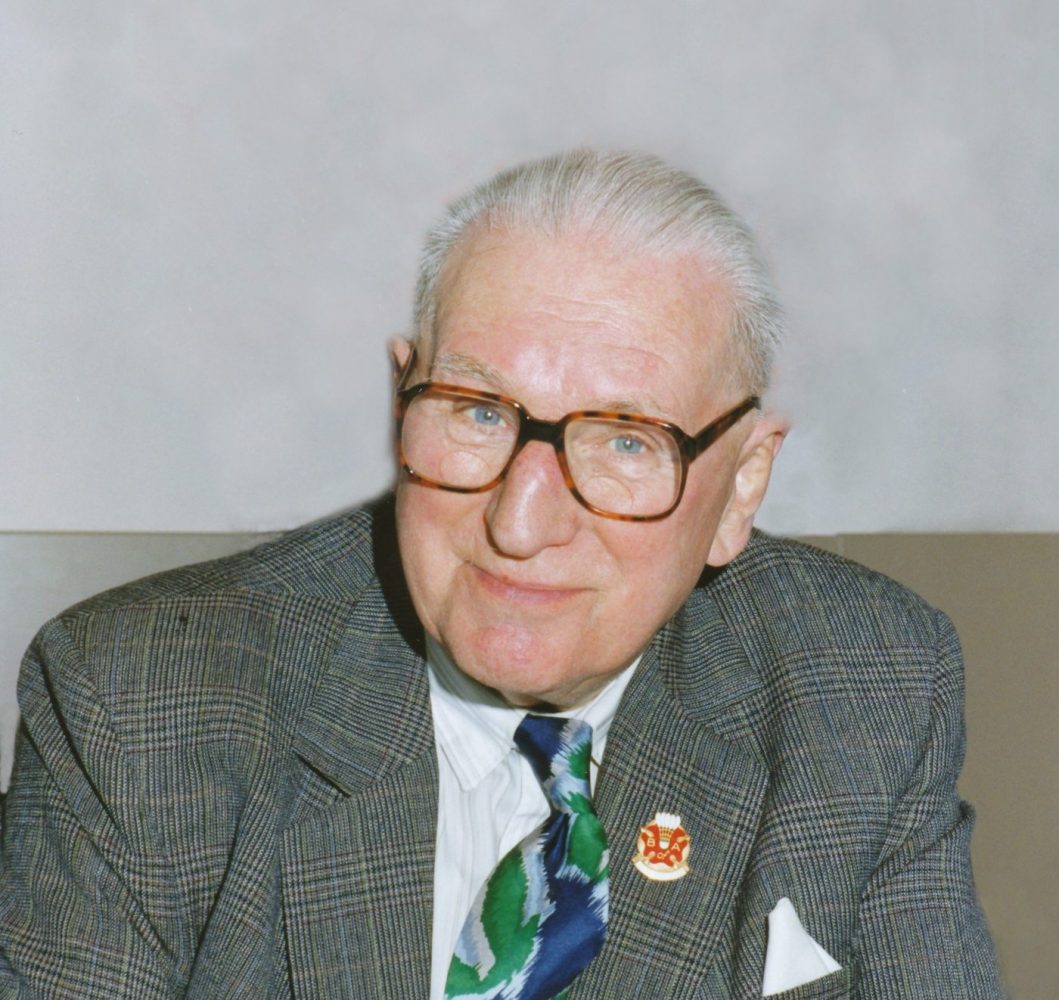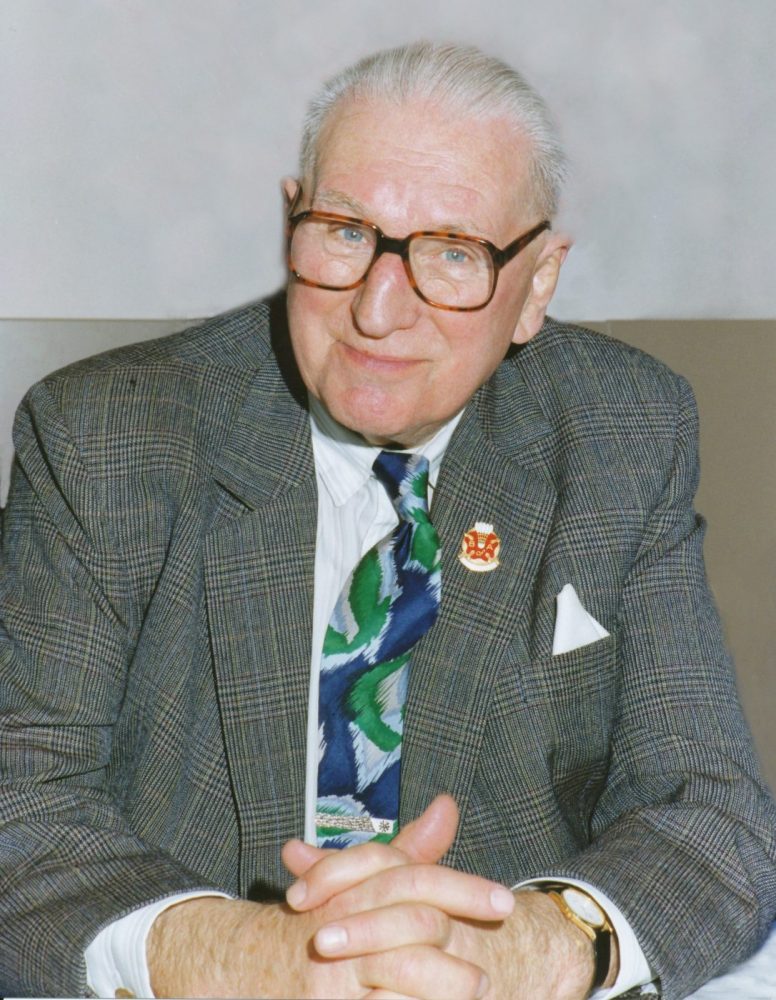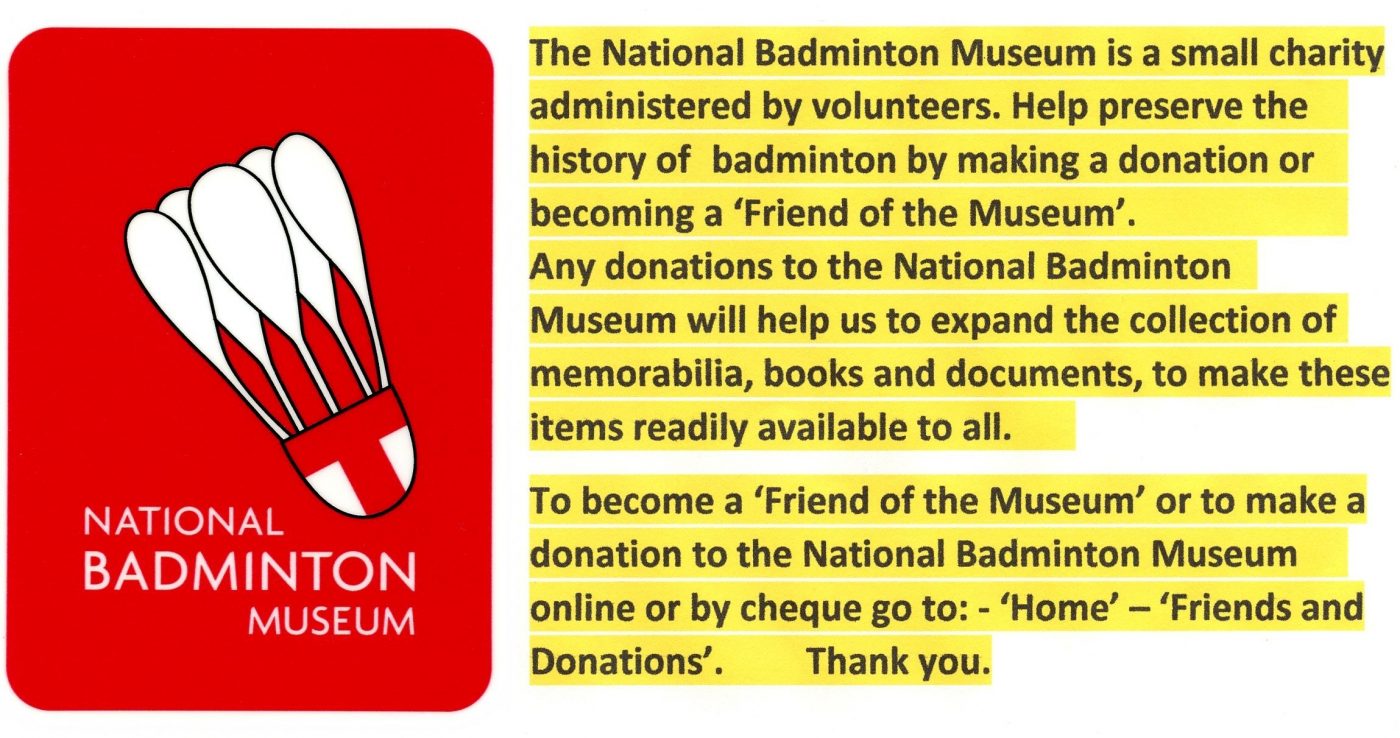This article by Peter Birtwistle appeared in the October 1947 Badminton Gazette. Peter Birtwistle a tireless badminton administrator, whose involvement in badminton stretched back beyond the Second World War.
He was a 2nd Lieutenant with British Expeditionary Force in France where he was taken prisoner at Dunkirk at the start of the Second World War and then spent the next five years in various German prisoner of war camps.
As the war was drawing to a close in 1945, an incident happened which was to change his life. He was part of a contingent being marched under German armed guards to a camp near Nuremberg, when the column was strafed with machine-gun fire by American Mustang aircraft who saw the Germans escorts and jumped to the conclusion that it was a German column. Peter received a serious shoulder injury which resulted in nine months of hospital stay and left him with a 40% disability.
Following demobilisation and release from hospital, Peter resumed his playing career and in 1948 won a place in the England team, playing for England five times between then and 1952.
Peter, an unforgettable “character” within the game, changed the face of badminton by campaigning to make it a popular spectator sport. Before that international events were not really promoted in the sense of ticket sales and drawing crowds, Peter proved that both were possible.
In 1977 he received the Queen’s Silver Jubilee Medal and in 1985 he was awarded the International Badminton Federation Herbert Scheele Medal for outstanding services to the game of badminton also the IBF Meritorious Service Award in 2000.
One of Peter’s proudest moments came in 1991 when he was elected President of The Badminton Association of England (now Badminton England).
Peter Birtwistle in 1995.
Photo: – Peter Richardson.
BADMINTON IN A PRISONER OF WAR CAMP by Peter Birtwistle.
When after the momentous events of the dark summer of 1940, some 2000 British officers and Other Ranks found themselves crowded into Oflag VII C, at Laufen, near Salzburg, at first they wanted nothing better than to be allowed to rest on their straw in their three-tier bunks. This utter wariness and lassitude were due to lack of food and the privations caused in some cases by the 250 mile march across Europe after capture on ersatz coffee and a few dog biscuits, and in the others by being locked in cattle trucks for some 72 hours, without the doors being opened for any reason whatsoever, so crowded in many cases that it was impossible to sit down, and with wounded and sick men on board. But in due course this wore off and then one of their main objects in life was to avoid boredom and ennui, to maintain morale. This was best attained by finding some interest, however insignificant compared to the epoch-making events of the outside world, which could keep them occupied mentally and/or physically.
So when it was known on the eventual arrival of mail from England, about November, that sports kit could be sent out, the idea of having badminton equipment sent found much favour. The camp was in the old palace of the Bishop of Salzburg; across the courtyard lay the old coach house, in which three reasonable courts could have been put. * Frank Henley’s (Reinforced Shuttlecocks Ltd) aid was sought through the medium of a letter home, to dispatch three nets, 12 rackets with spare gut and repair outfit, and as many shuttles as possible. And here, on behalf of all the Officers and Other Ranks who subsequently benefited with such enjoyment from the successful results of his help, so willingly and freely given, is placed on record their great appreciation of all that Frank Henley did for them by sending this equipment, and further supplies of shuttles, through those long and weary years. Without his aid, badminton in P.O.W. Camp might never have been.
** A.C. J. Van Vossen, of Denmark, later on when he was able, also sent tubes of shuttles, which were very much appreciated and most useful. He also sent throughout the war, in spite of great difficulties, whatever he could in the way of other things, particularly food parcels, which commenced with fortnightly deliveries and subsequently unfortunately became less frequent as things got scarcer. These were worth their weight in gold, and nothing could ever repay the help and pleasure they gave. Owing to the long delay in mail, the first batch of equipment did not arrive till July, 1941. By this time 500 of the younger men had been moved twice; to the reprisal underground health forts of near Fosen for three months, and then to Biberach, some 60 miles north of Lake Constance. There about 400 Officers captured in Greece joined up with the originals, but, unfortunately at this camp there was no indoors at all possible for playing badminton. So two outdoor courts were marked out where play was possible only when there was absolutely no wind at all, and it was surprising how even a breath, normally unnoticeable, can spoil outside badminton. Conditions were suitable only on very still day in the early morning or late evening. Strict rules had to be enforced prohibiting play if at all windy, as otherwise shuttles from the small and precious supply got damaged very quickly through the many resulting mishits. These conditions soon weeded out the many would-be players to the real enthusiasts. It was there that the P. O. W. Badminton Club was first formed. Every player was asked to write to his relatives at home to send 10 shillings to a fund from which the equipment sent out was paid. It transpired later that only about 50% was ever received!
In October, 1941, everyone was moved to a large camp at Warburg, near Kassel, where some 3000 British Officers including Royal Air Force, were concentrated from camps all over Germany. Here again there was nowhere possible for indoor badminton so outdoor courts were made under the same conditions as before. A further problem here was that many of the Officers, who had not been at Biberach, wanted to play, and there was not enough shuttles to last long for all who asked to play. However, it was felt that no one could be barred under the circumstances, so many further members were admitted for 5 shillings, and more shuttles were urgently sent for. Here again exposed position of the camp made plays so frequently impossible that numbers were soon reduce to the real enthusiasts; and, of course, for the same reason it was impracticable to organise any competitions.
In September, 1942 Warburg was disbanded into several smaller camps, and about 1600 of the younger Officers and Other Ranks were moved to what proved to be their last camp at Eichstatt, in Bavaria. Here, at long last, a building was eventually put at our disposal where indoor badminton of a sort could be played. It was only possible to fit in a court 12 feet short even with one baseline a few inches up the wall, so it was made two feet wider than normal to compensate. There was a pillar in the middle of the other baseline, which was a considerable hazard both in a game and to the precious rackets! In passing it was worth mentioning that all the original 12 rackets, Sheffields, except the one which got broken, were still in constant use and reasonable condition at the end, after five years hard usage by all types of players. Strings were repaired as necessary. Later some players had their own rackets sent out from England, and several were given to the club by the individuals.
The height of the building was low with two still lower beans over which a shuttle could be easily hit. The result of this “squat” court was that singles resembled a front and back mixed without the lady, with flat cross drives paying handsome dividends; doubles were rather cramped and not so strenuous, as one could not clear owing to the lack of height and depth, but everyone thoroughly enjoyed it. 400 Officers and Other Ranks kept the courts continuously from 7 am. to 8 pm. in the summer, the maximum length of time that the German guards allowed. Four clubs were formed, as equal in strength as possible, which all could join who wish to play league matches. Each club ran four teams, one in each division of the league. This scheme enabled all to get good games against more or less equal opponents, as each player found his own level. 18 consisted of four players, and a match of four singles and two doubles. Each player played his opposing string in a singles and then each doubles pair played their opposing number. Players could play friendly games with their friends if they wished, but a player couldn’t play both friendlies and in the league, as the large number playing made this impossible. It was most important in the P. O. W. Camp that everyone should get the same amount of play, as if somebody got one game more than somebody else all sorts of allegations about “rackets” flew about. As a result, a detailed and comprehensive booking system was essential, so that it could be absolutely fair, but yet involved a little effort to get a court, as some far from keen players would always play if pushed on a court with rackets and shuttles in their hands! This system did help the keener players. In addition an exact balance had to be struck between league and nonleague players, so that all got the same amount of play; not an easy task. Great care had to be taken about the issuing of rackets and shuttles, on which a very tight rein had to be kept.
Two tournaments were organised, one at each end of the season, with the league matches between them. Level and handicap singles and handicap doubles events were held. The “Hall” was finally put out of bounds by the German guards in the autumn of 1944, after the discovery of a tunnel leading from an adjoining room in the same building. Eichstatt camp finally broke up in April, 1945, when the occupants were moved by route march on the approach of the Americans. By thereby hangs another story. So, P. O. W. Badminton is no more, and it is hoped that those who derived such fun from this squat dwarf of a court, which did so much to relieve the ennui and maintain spirits, are now enjoying their badminton under conditions altogether different.
by Peter Birtwistle
Please note: –
*Frank Henley MBE, Sales Director, Reinforced Shuttlecocks Ltd (RSL). Frank Henley was born in Liverpool and emigrated to the United States as a very young man. There he was employed with the Pullman Car Company but returned to join up in the 1914-18 war. At its conclusion, he returned to England and became associated with the sporting goods manufacturing business. In that capacity he was in 1953 awarded the MBE, in the Coronation Honours list, he passed away 7th November 1956 at the age of 64.
** A.C.J. van Vossen represented Denmark in the inaugural General Meeting of IBF ( now Badminton World Federation (BWF) on 5 July 1934 where he was elected to the Executive Committee of the Federation.
Here he stayed for the rest of his life, from 1940 as Vice-President and finishing his career as President of IBF from 1959 – 1961, when he passed away in March 1961 holding office.
IBF President: 1959-1961
A.C.J. van Vossen was a Dutch businessman and badminton enthusiast who was quite instrumental to the spread of the game from the British Isles to the European continent in the 1930’s.
In 1932 he was elected Head of Selectors and Board member, a few years later in 1936 Vice-President, of the young Danish Association.
In particular, he served his adopted country as ‘Secretary of Foreign Relations’. Denmark had in 1932 joined the Badminton Association and A.C.J. van Vossen was for the next almost twenty years the Danish representative here and in IBF.
Thanks to his efforts and international contacts the Irish Strollers of J.D.M. Mc Callum visited Denmark and other countries on the continent in the 1930’s and inspired and catalyzed the development of badminton wherever they came and played.
He also arranged the first ever match between his home country of the Netherlands and Denmark in Nordwijk in 1932 and even played for Denmark in this match at the age of 50.
Van Vossen took great pride in the progress and achievements of his players and celebrated a highlight of his badminton life when as team Manager he returned to Denmark in 1939 with the first Danish All England title to Tage Madsen in Men’s Singles.
In the early 1950’s A.C.J. van Vossen retired from his oil business in Copenhagen and returned to the Netherlands. He continued, however, to serve as Vice-President of IBF, from 1952 representing the Netherlands.
In 1959 he was elected to the IBF Presidency.
— By William Kings
————————————————————————–If you have any badminton memorabilia, archive material, or any other items and would like to donate them to the National Badminton Museum please contact us at: –
museum@badmintonengland.co.uk
Thank you to all the ‘Friends of the Museum’ and people who have made donations to the National Badminton Museum, your support enables us to purchase extremely rare badminton artefacts for the National Collection as they become available.
———————————-



